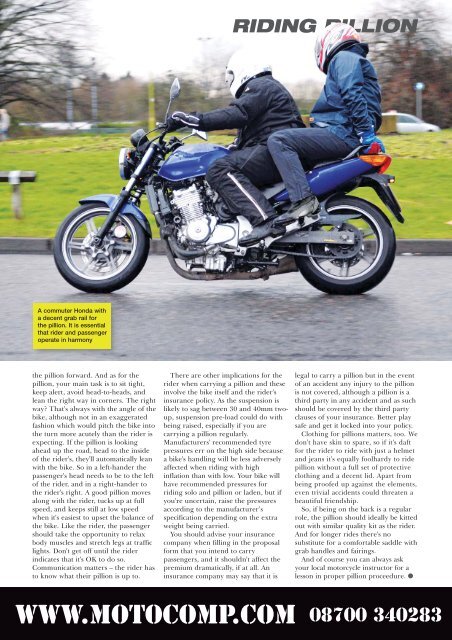what's legal? - Motorcycling Matters
what's legal? - Motorcycling Matters
what's legal? - Motorcycling Matters
You also want an ePaper? Increase the reach of your titles
YUMPU automatically turns print PDFs into web optimized ePapers that Google loves.
A commuter Honda with<br />
a decent grab rail for<br />
the pillion. It is essential<br />
that rider and passenger<br />
operate in harmony<br />
the pillion forward. And as for the<br />
pillion, your main task is to sit tight,<br />
keep alert, avoid head-to-heads, and<br />
lean the right way in corners. The right<br />
way? That's always with the angle of the<br />
bike, although not in an exaggerated<br />
fashion which would pitch the bike into<br />
the turn more acutely than the rider is<br />
expecting. If the pillion is looking<br />
ahead up the road, head to the inside<br />
of the rider's, they'll automatically lean<br />
with the bike. So in a left-hander the<br />
passenger's head needs to be to the left<br />
of the rider, and in a right-hander to<br />
the rider's right. A good pillion moves<br />
along with the rider, tucks up at full<br />
speed, and keeps still at low speed<br />
when it's easiest to upset the balance of<br />
the bike. Like the rider, the passenger<br />
should take the opportunity to relax<br />
body muscles and stretch legs at traffic<br />
lights. Don't get off until the rider<br />
indicates that it's OK to do so.<br />
Communication matters – the rider has<br />
to know what their pillion is up to.<br />
There are other implications for the<br />
rider when carrying a pillion and these<br />
involve the bike itself and the rider's<br />
insurance policy. As the suspension is<br />
likely to sag between 30 and 40mm twoup,<br />
suspension pre-load could do with<br />
being raised, especially if you are<br />
carrying a pillion regularly.<br />
Manufacturers' recommended tyre<br />
pressures err on the high side because<br />
a bike's handling will be less adversely<br />
affected when riding with high<br />
inflation than with low. Your bike will<br />
have recommended pressures for<br />
riding solo and pillion or laden, but if<br />
you're uncertain, raise the pressures<br />
according to the manufacturer’s<br />
specification depending on the extra<br />
weight being carried.<br />
You should advise your insurance<br />
company when filling in the proposal<br />
form that you intend to carry<br />
passengers, and it shouldn't affect the<br />
premium dramatically, if at all. An<br />
insurance company may say that it is<br />
RIDING PILLION<br />
<strong>legal</strong> to carry a pillion but in the event<br />
of an accident any injury to the pillion<br />
is not covered, although a pillion is a<br />
third party in any accident and as such<br />
should be covered by the third party<br />
clauses of your insurance. Better play<br />
safe and get it locked into your policy.<br />
Clothing for pillions matters, too. We<br />
don't have skin to spare, so if it's daft<br />
for the rider to ride with just a helmet<br />
and jeans it's equally foolhardy to ride<br />
pillion without a full set of protective<br />
clothing and a decent lid. Apart from<br />
being proofed up against the elements,<br />
even trivial accidents could threaten a<br />
beautiful friendship.<br />
So, if being on the back is a regular<br />
role, the pillion should ideally be kitted<br />
out with similar quality kit as the rider.<br />
And for longer rides there's no<br />
substitute for a comfortable saddle with<br />
grab handles and fairings.<br />
And of course you can always ask<br />
your local motorcycle instructor for a<br />
lesson in proper pillion proceedure. ●


